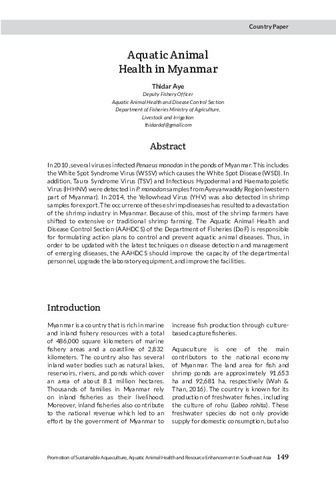Perlihatkan publikasi sederhana
Aquatic animal health in Myanmar
| dc.contributor.author | Aye, Thidar | |
| dc.contributor.editor | Aya, Frolan A. | |
| dc.contributor.editor | de la Peña, Leobert D. | |
| dc.contributor.editor | Salayo, Nerissa D. | |
| dc.contributor.editor | Tendencia, Eleonor A. | |
| dc.date.accessioned | 2021-12-16T02:40:13Z | |
| dc.date.available | 2021-12-16T02:40:13Z | |
| dc.date.issued | 2021-12 | |
| dc.identifier.citation | Aye, T. (2021). Aquatic animal health in Myanmar. In F. A. Aya, L. D. de la Peña, N. D. Salayo, & E. A. Tendencia (Eds.), Proceedings of the International Workshop on the Promotion of Sustainable Aquaculture, Aquatic Animal Health, and Resource Enhancement in Southeast Asia (pp. 149–153). Tigbauan, Iloilo, Philippines: Aquaculture Department, Southeast Asian Fisheries Development Center. | en |
| dc.identifier.isbn | 9789719931102 (Print) | |
| dc.identifier.isbn | 9789719931119 (PDF) | |
| dc.identifier.uri | http://hdl.handle.net/10862/6268 | |
| dc.description.abstract | In 2010, several viruses infected Penaeus monodon in the ponds of Myanmar. This includes the White Spot Syndrome Virus (WSSV) which causes the White Spot Disease (WSD). In addition, Taura Syndrome Virus (TSV) and Infectious Hypodermal and Haematopoietic Virus (IHHNV) were detected in P. monodon samples from Ayeyarwaddy Region (western part of Myanmar). In 2014, the Yellowhead Virus (YHV) was also detected in shrimp samples for export. The occurrence of these shrimp diseases has resulted to a devastation of the shrimp industry in Myanmar. Because of this, most of the shrimp farmers have shifted to extensive or traditional shrimp farming. The Aquatic Animal Health and Disease Control Section (AAHDCS) of the Department of Fisheries (DoF) is responsible for formulating action plans to control and prevent aquatic animal diseases. Thus, in order to be updated with the latest techniques on disease detection and management of emerging diseases, the AAHDCS should improve the capacity of the departmental personnel, upgrade the laboratory equipment, and improve the facilities. | en |
| dc.language.iso | en | en |
| dc.publisher | Aquaculture Department, Southeast Asian Fisheries Development Center | en |
| dc.rights | Attribution-NonCommercial-ShareAlike 3.0 IGO | * |
| dc.rights.uri | http://creativecommons.org/licenses/by-nc-sa/3.0/igo/ | * |
| dc.subject | Myanmar | en |
| dc.subject | prawns and shrimps | en |
| dc.title | Aquatic animal health in Myanmar | en |
| dc.type | Conference paper | en |
| dc.citation.spage | 149 | |
| dc.citation.epage | 153 | |
| dc.citation.conferenceTitle | Proceedings of the International Workshop on the Promotion of Sustainable Aquaculture, Aquatic Animal Health, and Resource Enhancement in Southeast Asia | en |
| dc.subject.asfa | animal diseases | en |
| dc.subject.asfa | health | en |
| dc.subject.asfa | shrimp culture | en |
| dc.subject.asfa | fish diseases | en |
Files in this item
Publikasi ini ada di koleksi berikut
-
Promotion of Sustainable Aquaculture, Aquatic Animal Health, and Resource Enhancement in Southeast Asia (SARSEA) [31]
Proceedings of the International Workshop on the Promotion of Sustainable Aquaculture, Aquatic Animal Health, and Resource Enhancement in Southeast Asia 25–27 June 2019, Iloilo City, Philippines



